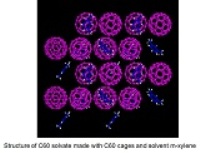A research team headed by Lin Wang from Carnegie Institution has discovered a new superhard form of carbon clusters, which exhibit both crystalline and amorphous structure and are comparable to diamond.
 The structure of carbon-60 solvate made with C-60 cages and m-xylene solvent.
The structure of carbon-60 solvate made with C-60 cages and m-xylene solvent.
This discovery holds potential in a variety of electronic, mechanical and electrochemical applications. The study findings have appeared in the journal, Science. Although researchers have not previously observed hybrid materials featuring both amorphous and crystalline elements, they believed that it is possible to create such materials.
The researchers began with a material carbon-60 cages, composed of highly aligned carbon balls made of pentagon and hexagon rings connected together to create a round, hollow form. They then put an organic xylene solvent in the gaps between the balls and created a new structure, and subjected this mix of carbon cages and solvent to different pressures to observe the structural modifications under different stresses.
The carbon-60's cage structure was not affected under comparatively low pressure. However, the cage structures began to crumple largely into clusters of amorphous carbon when there was an increase in pressure. Nevertheless, these amorphous clusters still retained their original sites, thus creating a lattice structure.
The researchers observed that they have created the new carbon structure under a critical pressure of 320,000 folds the normal atmosphere. The resulting carbon clusters retain their hybrid structure even after the removal of pressure. This is significant for identifying practical applications for the new material in the future.
The researchers also discovered that the removal of the solvent by heat treatment results in the loss of the material’s lattice periodicity. This confirms that the solvent is vital to maintain the chemical transition, which is the basis of the new structure. Since several similar solvents are available, a range of similar, but mildly different, carbon lattices can be theoretically synthesized utilizing this pressure technique.